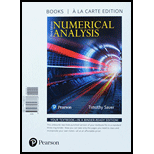
Numerical Analysis, Books A La Carte Edition (3rd Edition)
3rd Edition
ISBN: 9780134697338
Author: Timothy Sauer
Publisher: PEARSON
expand_more
expand_more
format_list_bulleted
Question
Chapter 11.3, Problem 2E
a)
To determine
To draw the Huffman tree and code the given message, and to compare the information with the average number of bits needed per symbol.
b)
To determine
To draw the Huffman tree and code the given message and compare the information with the average number of bits needed per symbol.
C)
To determine
To draw the Huffman tree and code the given message and compare the information with the average number of bits needed per symbol.
Expert Solution & Answer
Want to see the full answer?
Check out a sample textbook solution
Students have asked these similar questions
Explain the key points and reasons for 12.8.2 (1) and 12.8.2 (2)
Q1:
A slider in a machine moves along a fixed straight rod. Its
distance x cm along the rod is given below for various values of the time. Find the
velocity and acceleration of the slider when t = 0.3 seconds.
t(seconds)
x(cm)
0 0.1 0.2 0.3 0.4 0.5 0.6
30.13 31.62 32.87 33.64 33.95 33.81 33.24
Q2:
Using the Runge-Kutta method of fourth order, solve for y atr = 1.2,
From
dy_2xy +et
=
dx x²+xc*
Take h=0.2.
given x = 1, y = 0
Q3:Approximate the solution of the following equation
using finite difference method.
ly -(1-y=
y = x), y(1) = 2 and y(3) = −1
On the interval (1≤x≤3).(taking h=0.5).
Ф
sketch stability
x= -4x + 2xy - 8
y° =
4 y 2 - x²
чуг.
Chapter 11 Solutions
Numerical Analysis, Books A La Carte Edition (3rd Edition)
Ch. 11.1 - Use the 22 DCT matrix and Theorem 11.2 to find the...Ch. 11.1 - Prob. 2ECh. 11.1 - Prob. 3ECh. 11.1 - Prob. 4ECh. 11.1 - Prob. 5ECh. 11.1 - (a) Prove the trigonometric formula...Ch. 11.1 - Prob. 7ECh. 11.1 - Plot the data from Exercise 3, along with the DCT...Ch. 11.1 - Plot the data along with the m=4,6, and 8 DCT...Ch. 11.1 - Plot the function f(t), the data points...
Ch. 11.2 - Prob. 1ECh. 11.2 - Prob. 2ECh. 11.2 - Prob. 3ECh. 11.2 - Use the quantization matrix Q=[ 102020100 ] to...Ch. 11.2 - Prob. 1CPCh. 11.2 - Prob. 2CPCh. 11.2 - Obtain a grayscale image file of your choice, and...Ch. 11.2 - Carry out the steps of Computer Problem 3, but...Ch. 11.2 - Obtain a color image file of your choice. Carry...Ch. 11.2 - Prob. 6CPCh. 11.3 - Prob. 1ECh. 11.3 - Prob. 2ECh. 11.3 - Draw a Huffman tree and convert the message,...Ch. 11.3 - Translate the transformed, quantized image...Ch. 11.4 - Prob. 1ECh. 11.4 - Prob. 2ECh. 11.4 - Prob. 3ECh. 11.4 - Prob. 4ECh. 11.4 - Prob. 5ECh. 11.4 - Prob. 6ECh. 11.4 - Prob. 7ECh. 11.4 - Prob. 8ECh. 11.4 - Prob. 9ECh. 11.4 - Prob. 10ECh. 11.4 - Prob. 1CPCh. 11.4 - Prob. 2CPCh. 11.4 - Prob. 1SACh. 11.4 - Prob. 2SACh. 11.4 - Prob. 3SACh. 11.4 - Prob. 4SACh. 11.4 - Prob. 5SACh. 11.4 - Prob. 6SACh. 11.4 - Build two separate subprograms, a coder and a...
Knowledge Booster
Similar questions
- 2 Q/Given H (x,y) = x² + y² - y² Find the Hamiltonian System and prove it is first integral-arrow_forwardQ2) A: Find the region where ODEs has no limit cycle: x = y + x³ y=x+y+y³ 6arrow_forwardQ3)A: Given H(x,y)=x2-x+ y²as a first integral of an ODEs, find this ODES corresponding to H(x,y) and show the phase portrait by using Hartman theorem and by drawing graph of H(x,y)-e. Discuss the stability of critical points of the corresponding ODEs.arrow_forward
- Which angles are complementary to each other? Select all that apply. 3 2 4 in 5 1 Z1 and 23 Z1 and 25 22 and 23 Z2 and 25 Submitarrow_forwardWhich angles are adjacent to each other? Select all that apply. 3 2 4 67 5 8 11 10 12 12 9 27 and 28 Z9 and 12 Z3 and 24 Z10 and Z11arrow_forwardIf the arc length of NMP is 11π, what is the length of MNP expressed in terms of πT? M N 5 44% ○ A. 54π OB. 108π P О с. 103 18 O D. 108arrow_forward
arrow_back_ios
SEE MORE QUESTIONS
arrow_forward_ios
Recommended textbooks for you
 Mathematics For Machine TechnologyAdvanced MathISBN:9781337798310Author:Peterson, John.Publisher:Cengage Learning,
Mathematics For Machine TechnologyAdvanced MathISBN:9781337798310Author:Peterson, John.Publisher:Cengage Learning,

Mathematics For Machine Technology
Advanced Math
ISBN:9781337798310
Author:Peterson, John.
Publisher:Cengage Learning,